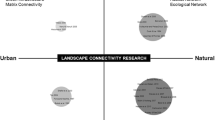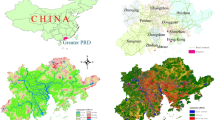Abstract
As a global and regional environmental problem, desertification assessment is an instrumental component in developing global/regional actions plans aimed at preventing and/or eradicating desertification issues. Using a landscape assessment approach allows for relatively quick assessments of desertification that can then be used in developing practicable application plans at the regional level in desertification prevention planning and decision-making. This study was conducted to determine whether a cost-distance connectivity index could both reveal evidence of, and act as an indicator for, desertification. Cost-distance, a simple GIS-calculated connectivity measure, was applied to a 1997 land use map to indicate desertification in Minqin County, China. The results showed that connectivity based on cost-distance follows basic landscape ecological principles including species–area relations and edge effects, and indicates desertification. Although grain size had a significant effect on the cost-distance index, especially at patch boundaries, log cost-distance closely corresponded with degree of desertification within grain size. Changing the extent of analysis had no significant effect on the cost-distance index and its relevance to degree of desertification. The Minqin County landscape had a high level of connectivity, although the area’s grasslands, oasis irrigated cultivated lands, alkali-saline lands and forestlands played important roles in resisting desertification. Three areas require restoration of native vegetation or afforestion to cut the connectivity of desertified patches. The application of connectivity based on cost-distance provides a straightforward, easily visualized description of desertification. In addition, land use data is readily available in China, allowing for relatively easy and quick assessments of regional level desertification for planning and decision-making.











Similar content being viewed by others
References
Adriaensen F, Chardon JP, Blust GD, Swinnen E, Villalba S, Gulinck H, Matthysen E (2003) The application of ‘least-cost’ modeling as a functional landscape model. Landscape Urban Plan 64:233–247
Chardon JP, Adriaensen P, Matthysen E (2003) Incorporating landscape elements into a connectivity measure: a case study for the speckled wood butterfly (Pararge aegeria L.). Landscape Ecol 18:561–573
Food and agriculture organization of the United Nations (1979) A provisional assessment of soil degradation. FAO, Rome, Italy, pp 48–49
Fryrear DW, Krammes CA, Williamson DL, Zobeck TM (1994) Computing the wind erodible fraction of soils. J Soil Water Conserv 49:183–188
Glenn E, Smith MS, Squires V (1998) On our failure to control desertification: implications for global change issues, and a research agenda for the future. Environ Sci Policy 1:71–78
Gu BS (2002) Sandstorm coming from here: on-the-spot record of Minqin basin ecological deterioration (in Chinese). China Disaster Reducing 44:13–15
Jia BQ, Zhang ZQ, Ci LJ, Ren YP, Pan BR, Zhang Z (2004) Oasis land-use dynamics and its influence on the oasis environment in Xinjiang, China. J Arid Environ 56:11–26
Kepner WG, Watts CJ, Edmonds CM, Maingi JK, Marsh SE, Luna G (2000) A landscape approach for detecting and evaluating change in a semi-arid environment. Environ Monitoring Assess 64:179–195
Lee JT, Elton MJ, Thompson S (1999) The role of GIS in landscape assessment: using land-use-based criteria for an area of the Chiltern hills area of outstanding natural beauty. Land Use Policy 16:23–32
Li BS (1988) The ecological benefits and prevention on desertification of afforesting and regrassing in desertification region (in Chinese). J Arid Land Resour Environ 2(4):56–63
Li YC, Chen FH (2001) Water resources sustainable utilization counter measures in Minqin Basin of Gansu province (in Chinese). J Mountain Sci 19:465–469
Liu S (2004) Where do the sand-dust storms come from? Chinese Educ Soc 37:10–14
Ma J, Wei H (2003) The ecological and environmental problems caused by the excessive exploitation and utilization of groundwater resources in the Minqin Basin, Gansu Province (in Chinese). Arid Zone Res 20:261–265
Ma KW (ed) (2000) The technology of surveying China’s land resources (in Chinese). China land press, Beijing, China
Man D, Wang J, Yang Z (2001) A preliminary analysis on ecological changes in Minqin desert area (in Chinese). J Gansu Forest Sci Technol 26:28–31
Marulli J, Mallarach JM (2005) A GIS methodology for assessing ecological connectivity: application to the Barcelona metropolitan area. Landscape Urban Plan 71:243–262
McGarigal K, Cushman SA, Neel MC, Ene E (2002) FRAGSTATS: spatial pattern analysis program for categorical maps. Computer software program produced by the authors at the University of Massachusetts, Amherst. Available at the following web site: www.umass.edu/landeco/research/fragstats/fragstats.html
Minqin Land Management Bureau (1993) Land use survey of Minqin County, Gansu Province (in Chinese). Technical Report, Minqin land management bureau, Minqin, Gansu, China
Minqin Water Conservancy Bureau (1996) The ninth five-year water-saving irrigation planning of Minqin County, Gansu Province (in Chinese). Technical Report, Minqin Water Conservancy Bureau, Minqin, Gansu, China
Mouat D, Lancaster J, Wade T, Wickham J, Fox C, Kepner W, Ball T (1997) Desertification evaluated using an integrated environmental assessment model. Environ Monitoring Assess 48:139–156
O’Neill RV, Hunsaker CT, Jones KB, Riitters KH, Wickham JD, Schwartz PM, Goodman IA, Jackson BL, Baillargeon WS (1997) Monitoring environmental quality at the landscape scale: using landscape indicators to assess biotic diversity, watershed integrity, and landscape stability. BioScience 47(8):513–519
Pickett STA, Cadenasso ML (1995) Landscape ecology: spatial heterogeneity in ecological system. Science 269:331–334
Ricketts TH (2001) The matrix matters: effective isolation in fragmented landscapes. Am Nat 158:87–99
Schlesinger WH, Reynolds JF, Cunningham GL, Huenneke LF, Jarreli WM, Virginia RA, Whitford WG (1990) Biological feedbacks in global desertification. Science 247:1043–1048
State forestry administration of China (2002) The second national desertification survey report (in Chinese). Technical Report, State forestry administration of China, Beijing, China
Sun DF, Dawson R, Li B (2006) Agricultural causes of desertification risk in Minqin, China. J Environ Manage 79:348–356
Sun DF, Dawson R, Li H, Li BG (2005) Modeling desertification change in Minqin County, China. Environ Monitoring Assess 108:169–188
Taylor PD, Fahirg L, Henein K, Merriam G (1993) Connectivity is a vital element of landscape structure. Oikos 68:571–573
Tischendorf L, Fahirg L (2000) On the usage and measurement of landscape connectivity. Oikos 90:7–19
Tripathy GK, Ghosh TK, Shah SD (1996) Monitoring of desertification process in Karnataka state of India using multi-temporal remote sensing and ancillary information using GIS. Int J Remote Sensing 17:2243–2257
Verboom J, Foppen R, Chardon P, Opdam P, Luttikhuizen P (2001) Introducing the key patch approach for habitat networks with persistent populations: an example for marshland birds. Biol Conserv 100:89–101
Wang Q, Shi J, Zhang Z, Meng Z (2003) Current situation of the environment in Shiyang River Basin and its evolutionary trends (in Chinese). J Desert Res 23:46–52
Wu J (2004) Effects of changing scale on landscape pattern analysis: scaling relations. Landscape Ecol 19:125–138
Wu J, Shen W, Sun W, Tueller PT (2002) Empirical patterns of the effects of changing scale on landscape metrics. Landscape Ecol 17:761–782
Yang Y (2003) The analysis of the oasis environmental change and its reason of the lower reaches of the arid region: a case study of Minqin County in the lower reaches of Shiyang River in Hexi Corridor, Gansu Province (in Chinese). Human Geogr 18:42–47
Zhang DB, Wang KX (1999) The effect of high-stand folded sand barrier and its influence on the railway region sand movement. In: Wang JH (ed) The combating desert theory and application in Gansu. Lanzhou university publishing house, Lanzhou, Gansu, China, pp 84–90
Zhao CX, Zheng DW, He WQ (2005) Vegetation cover changes over time and its effects on resistance to wind erosion. Acta Phytoecol Sinica 29(1):68–73
Acknowledgements
This research was supported by the Program for Changjiang Scholars and the Innovative Research Team (IRT0412). It was also funded by the key project research Grant No. 2002BA517A09 from the China Ministry of Science and Technology. We would like to thank all reviewers and editors for their valuable comments and suggestions during the review process.
Author information
Authors and Affiliations
Corresponding author
Rights and permissions
About this article
Cite this article
Sun, D., Dawson, R., Li, H. et al. A landscape connectivity index for assessing desertification: a case study of Minqin County, China. Landscape Ecol 22, 531–543 (2007). https://doi.org/10.1007/s10980-006-9046-6
Received:
Accepted:
Published:
Issue Date:
DOI: https://doi.org/10.1007/s10980-006-9046-6




